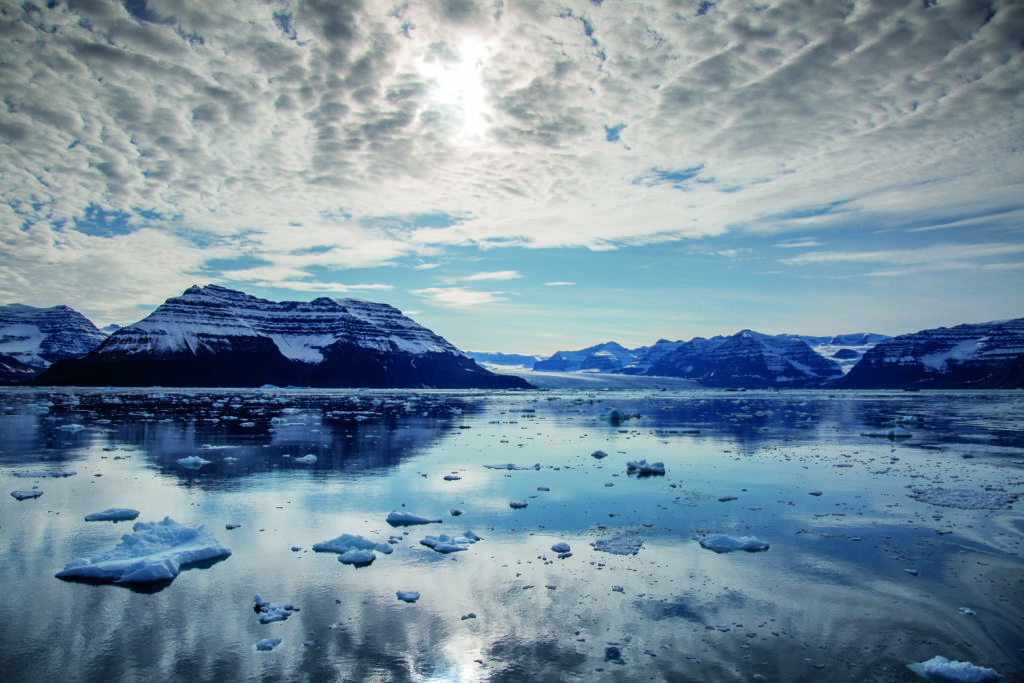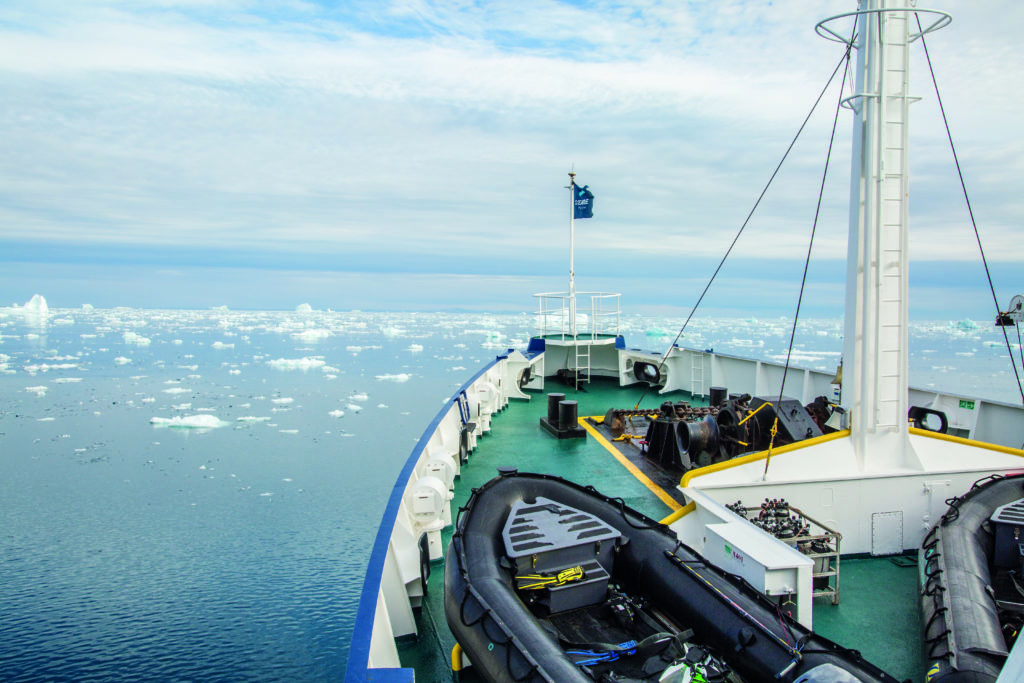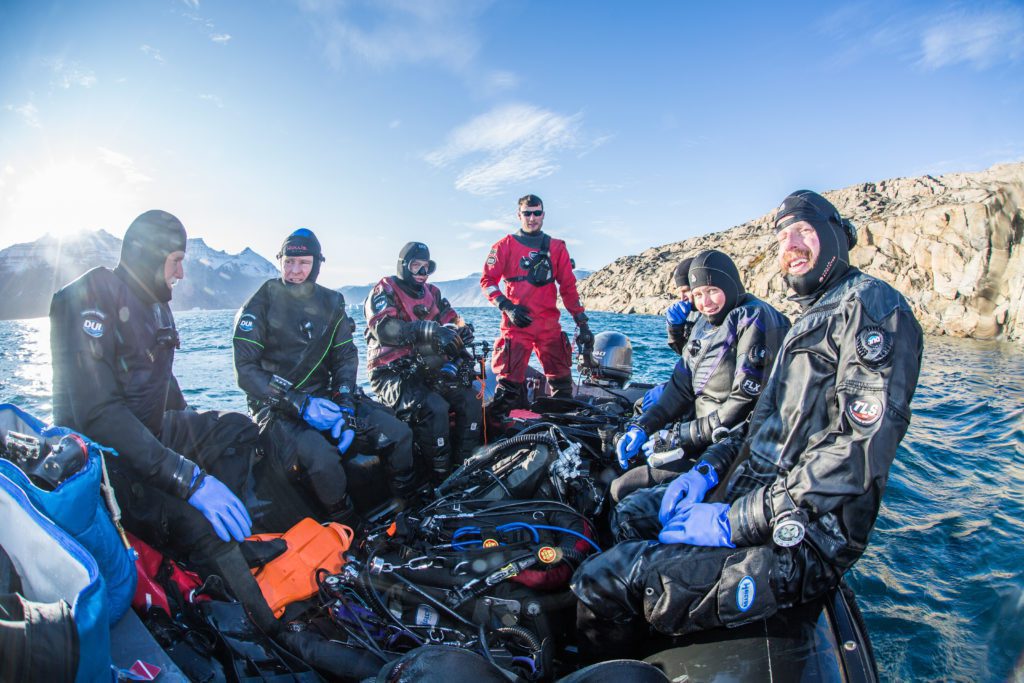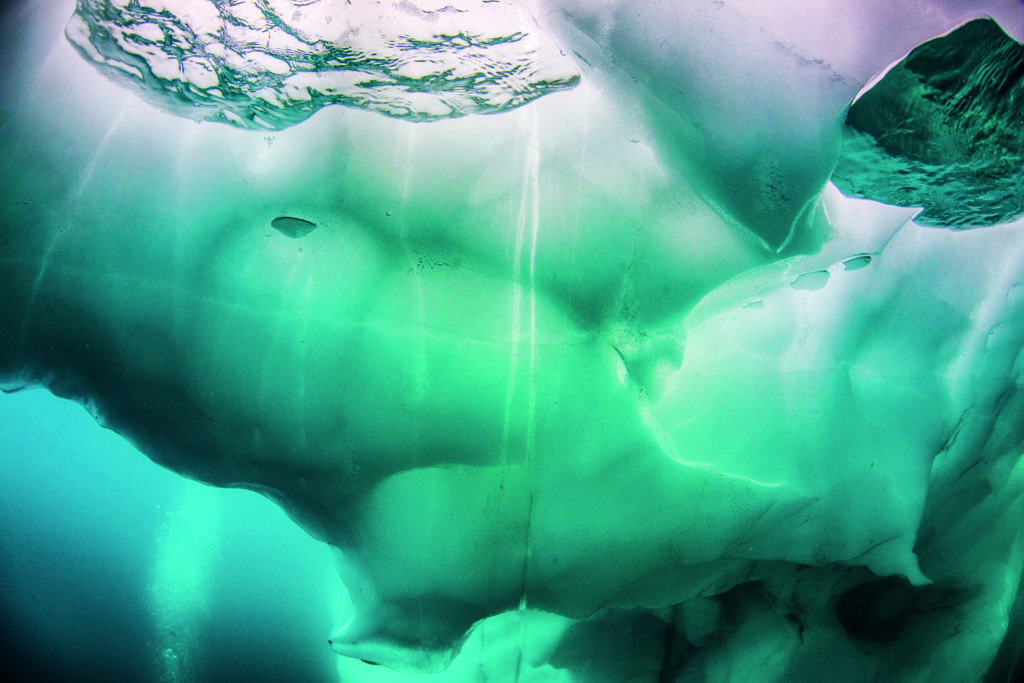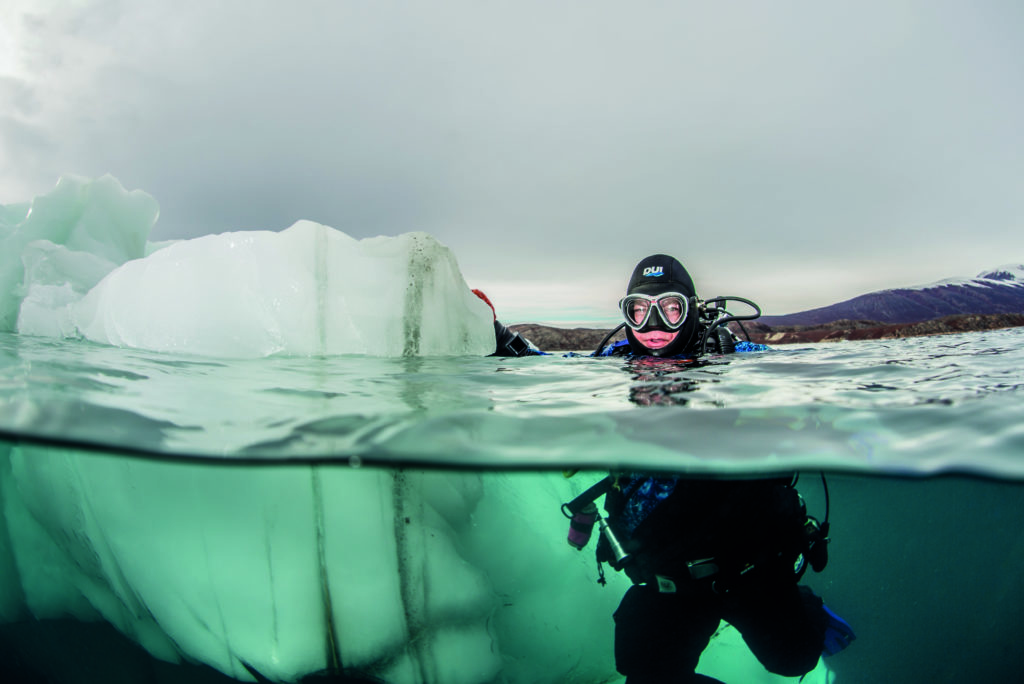Coldwater diving expert BYRON CONROY left his adopted home of Iceland to explore the freezing waters of Greenland and its shifting ‘population’ of monstrous icebergs
I have lived in Iceland for many years, so coldwater diving is very comfortable for me. I regularly dive in water as low as 1°C and also under the ice in the winter here in Iceland. However, when an offer for a trip to Greenland with Blue Green Expeditions came up, I couldn’t say no to taking my coldwater diving one step further.
Overview of Greenland
Greenland is the world’s largest island and, with a population of few more than 56,000 making the population density 0.028 people per sq km – compared to 259 per sq km for England – you realise that it’s going to be quite remote.
Some 75% of the island is also covered by the only permanent ice-sheet outside Antarctica.
During winter, much of the sea around Greenland is covered in pack-ice. Our trip took us to Scoresby Sund, on the east side of the country, during September when the pack-ice has melted, leaving behind an incredible fjord filled with huge icebergs that have calved from the glacier.
We departed from Akureyri in northern Iceland and began the 24-hour journey onboard our home for the week, the 89m Plancius. Built as an oceanic research vessel, she now runs trips to the polar regions. She has 53 cabins and can accommodate 108 guests, and also features wonderful holiday comforts such as a fine-dining restaurant and a bar.
To join a dive-trip to Greenland, a good amount of serious coldwater diving experience is required. That means a minimum of 50 logged drysuit dives, and I would highly recommend that as many of these as possible are conducted in waters of less than 10°C.
Also, all your own personal equipment is needed, including drysuit, undergarments and two independent first stages that are environmentally sealed. All dive-tanks there have two valves on them, because of the risk of first-stage freezing and freeflowing regulators.
Start of our journey
We boarded at 3pm local time and settled in for the overnight trip to Scoresby. Dinner was served and everyone began talking about the excitement of diving in Greenland. The diving there is mainly unexplored, and there are no dive-site names or itineraries – this is true exploration in the Arctic.
During the first night onboard, as we crossed the Denmark Strait, we were able to see the Northern Lights from the viewing deck. It was an incredible sight for all the participants and an amazing start to the trip. To stand under the glowing lights and know that we were heading for unexplored diving and pristine seas created a real buzz among the travellers.
The following day we woke to rough conditions and experienced the power of the northern seas, with big swells all around us for most of the day as we continued north.
In the late afternoon we entered the fjord and began to see the first small icebergs along its edge. As the sunlight retreated, we were again treated to another incredible Northern Lights show.
The diving began the following day. We were blessed to be greeted by perfect seas with mirror reflections and, as I made my way to the sundecks, I saw the first glimpses of the inner fjord. There was not a breath of wind, and the icebergs were as large as multi-storey buildings, perfectly reflected in the surface of the fjord.
Through the ice-fields

It is hard to describe the majesty of cruising slowly through the icefield. The icebergs are so serene and calm, yet hold thousands of years of history within them and are simply beautiful. Also, knowing that usually around two-thirds of the ’berg is actually under water with only one thread breaking the surface got us all excited about the diving.
We sat down for the morning dive-briefing with the dive leader Henrik Enckell. He has been diving for more than 25 years in the world’s most difficult conditions in both the Arctic and Antarctic, and is also a technical and rebreather instructor. He has a very calming voice and is a strong leader, which gave us great confidence as we headed out to dive unexplored waters.
Henrik discussed with us the safety risks and protocols involved with extreme coldwater diving: freeflowing regulators, shutdown drills, drysuit flooding, hypothermia and so on, and set the tone for the group to realise that this was serious coldwater diving.
We decided on a shore / wall-dive for the first outing. We loaded all the gear into the inflatables and then headed down to meet them as they used a crane to lift them from the top of the ship.
After rolling into the sea and being sharply woken by extremely cold water hitting our faces, we began the dive. The water is around 1°C and yet it was teeming with unexpected life. There were many colourful sea anemones, nudibranchs, jellyfish and seastars – a perfect macro-diver’s heaven.
The wall-dive came in the afternoon. We could now see the basalt columns that we had already seen above now under water, and were able to study Greenland’s geology. The wall was covered with beautiful anemones and all sorts of macro subjects, such as shrimps and sea slugs.
After a few nice, easy dives on day one, we settled in for the day two dive-briefings with Henrik. Now it was time for what we had all come for – diving under icebergs.
Henrik guided us through the safety procedures, and explained that because the icebergs are made from fresh water and the sea salt, you approach the iceberg weighted for salt but within 1m of the ’berg you find that it is melting and you’re now in an area of fresh water. That means that, if you don’t adjust your buoyancy on approach, you‘ll start to sink!
First and last to see an iceberg
There are also sometimes caves within the icebergs but we were forbidden to enter these. We also discussed the very real possibility of an iceberg flipping over during the dive.
We started by rolling off the inflatable and breaking through the pancake ice at the surface. This is a thin glass-like layer that forms when the sea is flat-calm. We descended in good visibility of around 15m. The iceberg was incredible to see under water, its dimpled surface reminding me of a golfball.
To swim away from the ’berg and see it in its entirety was amazing. The texture, the shape and the realisation that this iceberg and dive-site that was thousands of years old was melting, and in just a few weeks would no longer exist. We would be both the first people ever to see it under water and also the last.
Later in the day we crossed the fjord and ended up in Jytte Haun for a real expedition dive to a place where nobody had ever been recorded diving before.
The dive-site was a wall with a slight current, and enabled us to do our first drift-dive in the Arctic. As we drifted along the healthy wall we were amazed by the abundance of life in this inhospitable place. There were lumpsuckers, anemones, jellyfish and many other fish and nudibranch species I had not seen before, even after years of diving the North Atlantic in Iceland.
We also managed to take an inflatable trip around the fjord. This enabled us to get up close to the iceberg and take some amazing photographs. To be next to a ‘berg that’s bigger than a multi-storey apartment block was quite thrilling – as was knowing that it could tip over at any moment and create a big tidal wave!
As the evening drew to a close, we settled into a barbecue on the top deck of the ship. The atmosphere was lively as people discussed exploration and their first experiences of diving beneath icebergs.
The transparent iceberg
For day three of the diving, we headed towards Rode Island to visit an iceberg graveyard. We were joined by some snorkellers. This ice was different to that of the other ’berg we had dived because it was completely see-through.
With great visibility and a see-through iceberg, it was possible to see divers on its far side – and also to see the rocks and sand that had been frozen in time with the ice.
In the afternoon, after diving another ’berg with great visibility, we all boarded an iceberg for some photographs of the entire group, standing on top of it as it floated in the fjord.
Our final day’s diving would consist of a single morning dive. After such a great day with the icebergs previously, we decided to conduct another wall-dive that offered amazing macro photography options, and the opportunity to capture species we had never seen before.
In the afternoon we headed towards Hurry Inlet for a land excursion to the town of Ittoqortoormiit… not the easiest place to pronounce! We were given the opportunity to stroll around this small settlement at leisure, and it was great to be met by a local team-member who could mark our passports with a Greenland stamp.
The town was made up of small houses painted in every colour of the rainbow. We were able to explore the local church, police station and a museum showing traditional techniques for making tools, fishing equipment and boats.
Cool drinks
That evening we boarded Plancius for another splendid meal and began the cruise back to Iceland. The seas were more forgiving on the journey back and the guests were able to order drinks with ice cubes chipped away from a small iceberg that had been fished out of the sea.
Drinking gin & tonics cooled by ice-cubes thousands of years old, it was enjoyable to reflect on the real exploration we had conducted on our visit to Greenland.
Greenland diving is not for everyone. The seas can be harsh, the temperatures extreme and the conditions tough, but the rewards of spectacular topside scenery and the chance to be able to explore new dive-sites and see icebergs that only you will ever see is hard to resist for the more serious coldwater diver.
Photographs by Byron Conroy
Also on Divernet: Vanishing frontier, Divers find first Arctic fluo-fish, Andy Torbet: 10 things I won't dive without

